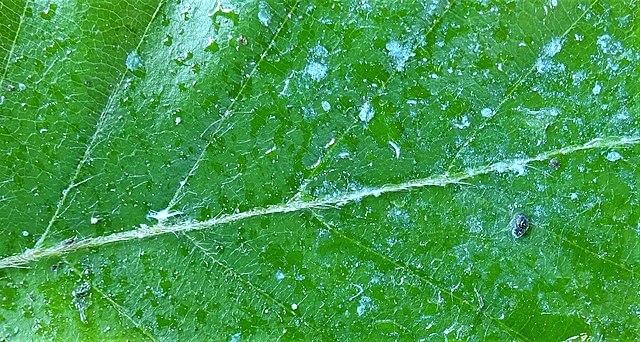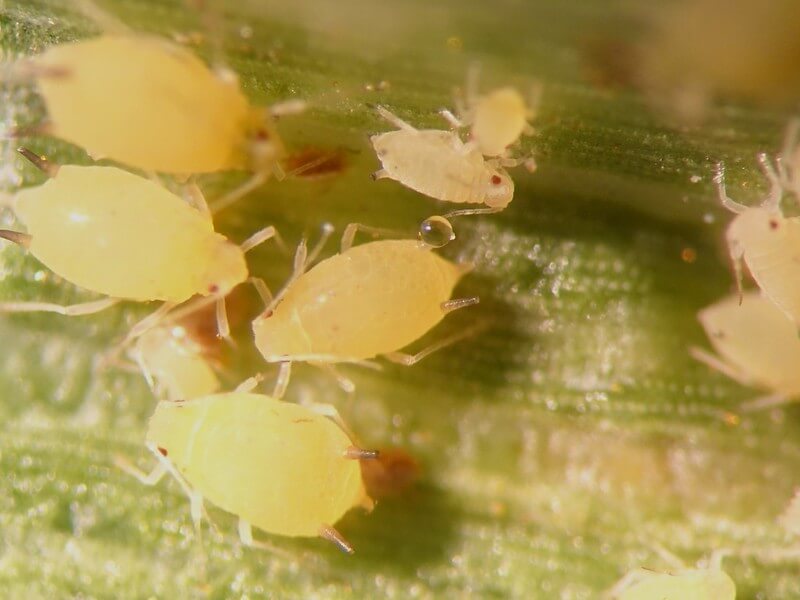What Can Turn Tree Sap into…Honeydew?
By John McCutcheon
Broadcast 7.2013 & 7.27 & 7.30.2022

Sticky aphid honeydew on a leaf. Photo by Roger Griffith, CC by-SA 4.0.
Listen:
The aphids of western Montana have made themselves known this year. Because of their emergence in such huge numbers, anything parked under a tree—be it a car, a boat or a sidewalk—quickly becomes covered by their sticky excreta, which is euphemistically known as “honeydew.” The singing cicadas are also out in the summertime, and can be heard calling loudly during the hottest part of the day.
Aphids and cicadas are both members of the same insect order, Hemiptera, which includes many different insects with sucking (as opposed to chewing or sponging) mouthparts. This group of insects also includes spittlebugs, which can be easily spotted in most gardens, because as nymphs they cover themselves in a white foamy spittle as protection. Most Hemiptera feed only on plant sap, which is remarkable, as sap is one of the least nutritious parts of plants. It contains extremely low levels of important nutrients, most especially the essential amino acids.
All living things, from bacteria to Homo sapiens, need 20 amino acids to survive. These 20 amino acids are the building blocks of proteins and enzymes that give a cell its structure and carry out its important chemistry. Most “simple” organisms such as bacteria and fungi can make all 20 amino acids from simple compounds that are abundant in the environment, but animals, including humans and insects, can make only 10 of the 20 amino acids. The other 10, the so-called essential amino acids, need to be acquired in animal diets.

A tiny droplet of honeydew excreted by an aphid. Photo by Scot Nelson, public domain.
So how do aphids, spittlebugs, and cicadas acquire these essential amino acids? First, they have to get the sap. For aphids, this is easy. Aphids eat phloem sap, which is the sugary sap that is transported from the leaves to the rest of the plant after photosynthesis. Phloem sap is under positive pressure, so all an aphid has to do is stick its piercing mouthpart into the right part of the plant, and the sap will start flowing. This process is perhaps similar to tapping a pressurized keg of beer. Aphids can go through a lot of phloem sap really quickly, and this helps explain the rain of honeydew observed this year.
Spittlebugs and cicadas, on the other hand, eat only xylem sap, which is the sap that comes up from the roots. Not only is xylem sap a very dilute food source, it’s under negative pressure, so spittlebugs and cicadas have to suck—hard—to get their food. This process is perhaps similar to sucking a thick milkshake through a straw, and explains the oversized heads of xylem-feeding insects, which are needed to accommodate their huge sucking muscles.
But what about the essential amino acids? Aphids and spittlebugs can (and do) take in sap all day long and still not get enough essential amino acids to build an animal body. Here’s where it gets interesting: these insects have evolved highly specialized relationships with certain bacteria to provide the nutrients that are missing in their diets. These symbiotic bacteria are only found in special insect cells, which together form large organs that exist exclusively to house their bacterial partners. Their relationships are incredibly stable: some of these bacteria—including those found in aphids, cicadas, and spittlebugs—have been associated with their insect hosts for hundreds of millions of years. Both the bacteria and insect need each other absolutely: the bacteria can likely live nowhere else, and the insects do not survive if “cured” of their bacterial symbionts.
Recent research has shown that most animals, humans included, have similarly important beneficial relationships with bacteria—they are not, as commonly thought, just the cause of disease and rot. For example, in humans, our gut bacteria play critical roles in immune development and extracting energy from the food we eat.
So the next time you hear the cicadas calling in the trees on a beautiful summer day, or the next time you fire up the hose to wash the honeydew off of your car—again—recall the beneficial bacteria involved…and think kindly of them.
Every week since 1991, Field Notes has inquired about Montana’s natural history. Field Notes are written by naturalists, students, and listeners about the puzzle-tree bark, eagle talons, woolly aphids, and giant puffballs of Western, Central and Southwestern Montana and aired weekly on Montana Public Radio.
Click here to read and listen to more Field Notes. Field Notes is available as a podcast! Subscribe on iTunes or wherever you listen to podcasts.
Interested in writing a Field Note? Contact Allison De Jong, Field Notes editor, at adejong [at] montananaturalist [dot] org or 406.327.0405.
Want to learn more about our programs as well as fun natural history facts and seasonal phenology? Sign up for our e-newsletter! You can also become a member and get discounts on our programs as well as free reciprocal admission to 300+ science centers in North America!












